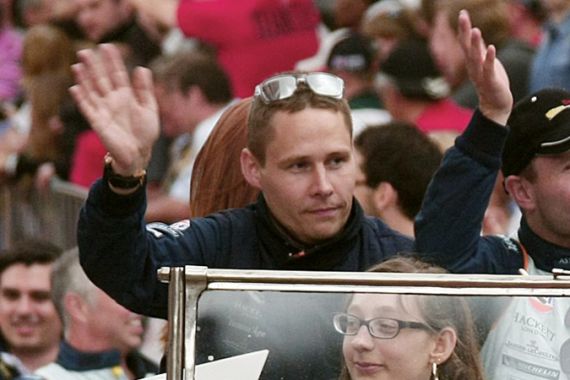Audi win tragedy-marred Le Mans
Audi celebrate fourth win in a row despite endurance race overshadowed by death of Danish driver Allan Simonsen.

Audi won the 24 Hours of Le Mans for the fourth straight year on Sunday and dedicated its victory to Aston Martin driver Allan Simonsen who died at the start of the endurance race.
The Dane was the first driver to die at Le Mans since 1997.
Tom Kristensen, Allan McNish and Loic Duval steered Audi No. 2 to victory on Sunday, one lap clear of Toyota No. 8 driven by Anthony Davidson, Sebastien Buemi and Stephane Sarrazin.
Just after taking the checkered flag, a tearful Kristensen dedicated his victory to Simonsen.
“This one is for Allan Simonsen,” Kristensen told Eurosport television.
“A fantastic driver. This is for him.”
Canadian driver Anthony Burgess later walked away from a spectacular crash in the 12th hour.
Record breakers
It was Duval’s first victory at the world’s most famous endurance race, but the third for McNish and the ninth for Kristensen, who extended his record for most titles by a driver.
Audi earned its 12th title at Le Mans, four shy of Porsche’s record. At the wheel of Audi No. 3, Oliver Jarvis, Marc Gene and Lucas Di Grassi took third place.
On Saturday, organisers said the 34-year-old Simonsen was taken to the hospital after his Aston Martin spun at high speed only 10 minutes into the race and skidded into the barrier at the Tertre Rouge corner where cars typically reach speeds of up to 170 kph (105 mph).
Simonsen died at the hospital soon after arrival “due to his injuries,” organizers said.
Aston Martin Racing, which entered five Vantage V8 cars in the GTE-Pro and GTE-Am classes, continued in the race at the request of Simonsen’s family.
Although Audi was much quicker than its Japanese rival, Toyota hoped fuel consumption and tire management could tip the scales in its favour during the race. But the strategy of the Japanese manufacturer was thwarted by the changing weather and the numerous safety car periods. The safety car came out 11 times, holding up the race for more than five hours.
Audi had the top three spots on the grid while Toyota started from fourth and fifth.
Toyota now has four three runner-up finishes at Le Mans but has never won.
The only Japanese manufacturer to win was Mazda in 1991.
Toyota briefly hit the front when the Audis pitted in the second hour. But the German manufacturer started dominating the race with its pace, recovering the top three spots in the third hour under pouring rain.
However, speed is no guarantee of victory. Reliability matters just as much in a competition won by the team that completes the most laps in 24 hours, with up to three drivers alternating.
Just when Audi looked irresistible on a track that was drying out, two of its cars faced reliability issues in the seventh hour.
Benoit Treluyer’s Audi No. 1 was stuck in the garage for more than 40 minutes because of a crank sensor failure and fell out of contention, finishing fifth. The Audi No. 3 driven by Jarvis had a puncture and later had his front bodywork changed.
Jarvis’ Audi No. 3 overtook Lapierre’s Toyota No. 7 in the 22nd hour to make the podium.
In the penultimate hour, Lapierre made a driving mistake under pouring rain, skidding off the slippery track at the Porsche curves to crash into the tire barrier. But Lapierre managed to limp his car back into the garage and finished fourth.
Drama
The endurance race had its traditional share of drama.
In the 12th hour, Burgess’ HVM Status GP No. 30 was shattered into pieces in a crash at the Porsche curves, but the Canadian driver managed to climb out of the car.
“It was obviously a great relief when we saw him walk away from the accident,” HVM Status GP technical director Rob Arnott told the team’s website.
“Many of the components are completely destroyed but the safety cell and everything else stood up to the impact incredibly well and it all absorbed the impact.”
“The Lola is a very safe car, and I have to say that the fact that it is a coupe minimised the risk to Tony, because he was protected from any parts that came loose in the impact. We are obviously bitterly disappointed about what happened, but thankful for the safety standards in our car.”
The action was not just on the track but also in the pit lane, where Matteo Malucelli’s Ferrari No. 51 briefly took a refueller with him and then bumped into Philippe Mondolot’s Morgan-Nissan No. 45 in the 21st hour.
After Simonsen’s accident, Aston Martin Racing continued in the race at the request of his family.
Sebastien Enjolras lost his life in pre-qualifying at Le Mans in 1997. The last driver fatality during the race itself was Jo Gartner in 1986.
The worst crash in Le Mans history occurred in 1955 when Pierre Levegh’s Mercedes flew into the crowd, killing more than 80 spectators.